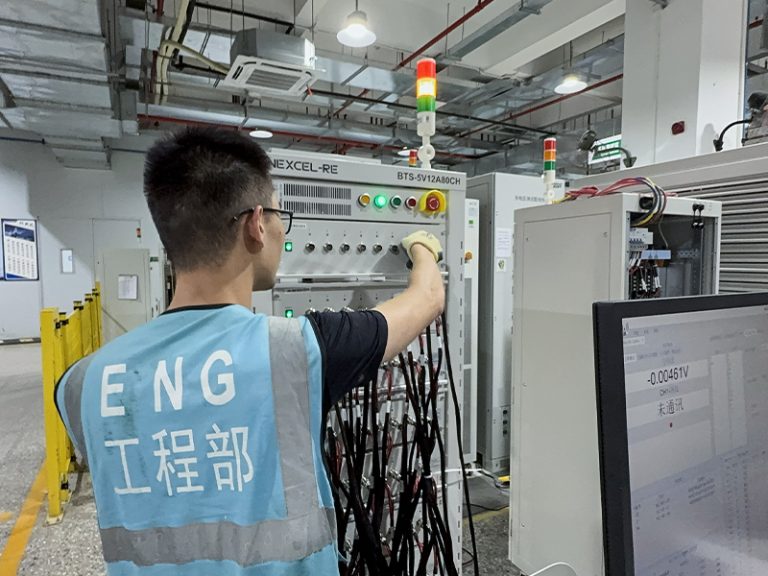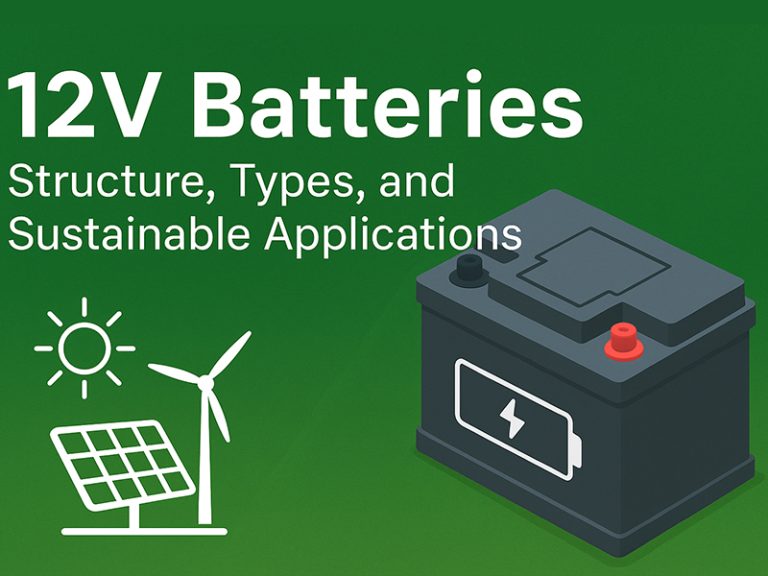Lithium and alkaline batteries are two very common types of batteries. They have numerous applications. Lithium batteries are categorized into many types based on the type of chemistry. Alkaline batteries also have types but their variation is based on the size. In this article, we will explore different types of both batteries, their performance parameters and differences in testing methods.All testing examples in this article are based on systems similar to SINEXCEL-RE Battery Test System.
Lithium Batteries and its Common Types:
In lithium batteries, lithium ions play major role in storing energy. Whatever be the type of lithium battery, a separator is used between two electrodes of battery. During charging process, lithium ions move towards negative electrode while passing through the separator. Direction of ion movement reverses during discharging phase.
Lithium batteries have six common types. Names of these types are based on their active material.
- LiFePO4 or LFP batteries are Lithium Iron Phosphate batteries which have phosphate as their cathode material. Nominal voltage of each cell in these battery is 3.2V. These are deep cycle batteries with good thermal stability, and long life cycle.
- LCO or Lithium Cobalt Oxide batteries are lithium batteries with low specific power and high specific energy. Indirectly, these batteries are good to power some device for longer hours but not suitable for applications which need high power instantly.
- LMO or Lithium Manganese Oxide batteries have their cathode built with lithium manganese oxide. Battery cells with this chemistry have good ion flow capability, low internal resistance, good thermal stability, and safety prospects.
- NMC or Lithium Nickel Manganese Cobalt Oxide batteries are also type of lithium batteries. Their cathodes are made of nickel, manganese, and cobalt, so battery benefits from characteristics of all three elements. These batteries have high specific energy and stable chemistry.
- NCA or Lithium nickel cobalt aluminum oxide is another common type of lithium battery. It has high specific energy but its specific power is not much high. Its life cycle is also good but this chemistry is not much safe and costs higher than other types.
- LTO or Lithium Titanate is unique from other types of lithium batteries. In all other types, cathode chemistry identifies name of battery variant. For LTO, lithium titanate is used to design anode and cathode chemistry is that of NMC or LMO type battery. These batteries can be charged rapidly making them suitable for Electric Vehicles (EVs) and backup systems. These batteries are often tested with SINEXCEL-RE EV Battery Test System for performance validation.Their operating temperature range is wide. They are quite safe and have long life cycle. Anyhow, these batteries have low energy density and their manufacturing costs is also high.
Alkaline Batteries and its Common Types:
Alkaline battery is widely used primary battery. It is designed with various chemistries. One of the most common one is manganese dioxide/zinc chemistry which uses potassium hydroxide as an electrolyte. Negative electrode is composed of zinc metal (Zn), whereas positive electrode is composed of manganese dioxide (MnO2). Typically alkaline battery is non rechargeable because of two major reasons.
- Energy is required for charging process or reverse chemical reaction. In case of alkaline battery, this energy would be too high making use of this battery impractical.
- As high energy would be required to charge the cell, it will heat up the battery and operation would become very unsafe.
When it comes to types of alkaline batteries, there are 8 types on the basis of size. These are A23, N, AAAA, AAA, AA, C, 9V, and D. A23 being smallest and D being the largest one. Here, all types of batteries are discussed briefly.
- “Double A” or AA is most commonly used battery size. Its nominal voltage is 1.5V and it is widely available battery cell type.
- “Triple A” or AAA battery is another very common battery type which is used for calculators, small toys, thermometers, and alike gadgets. Its nominal voltage is also 1.5V.
- “Quadruple A” or AAAA batteries are not much common. These batteries are thin but quite powerful ones.
- C batteries are heavy duty batteries. These are used for gadgets which demand high power like portable radios, and flashlights. These batteries are safe for frequently operated devices.
- D batteries are also big and power packed batteries. Preferably, these are used for devices which need energy for extended time periods. These are used in relatively big gadgets or devices like instant geysers, towel dispensers, and air freshener systems.
- 9V batteries are rectangular batteries which furnish 9 volts. These are powerful batteries with high stability and durability. These batteries work well in temperatures ranging from 0 to 130 degrees Fahrenheit.
- 23A or A23 is a small sized battery which is used in small devices like watches and remotes. It delivers 12 volts nominal voltage. It is capable of providing instant high power bursts which might be infrequent.
- N type batteryis another small sized battery. It operates at 1.5V nominally. This is reliable battery cell which has high capacity and highest energy density.
Lithium vs. Alkaline Batteries: A Thorough Comparison
Here, different aspects like price, capacity, and performance are discusses side by side for lithium and alkaline batteries.
Cost:
Alkaline batteries are primary cells; it means, these are disposable batteries. Considering single time usage, cheap material is used to design its cells so their cost is lower. On the other hand, lithium batteries are expensive and their cost might go above 5 times than the cost of alkaline battery.
Output Stability:
Lithium batteries have quite stable operation. Till the end of the discharging curve, these batteries maintain their nominal voltage. For Alkaline batteries, output voltage keeps declining and goes below nominal output voltage.
It can also be related with self-discharge. Lithium batteries don’t experience very high self-discharge, but alkaline batteries have relatively higher self-discharge.
Voltage:
Each cell of alkaline batteries has 1.5V nominal voltage. For lithium batteries, this value ranges between 1.5 and 3.0V. you must note that it is voltage for a cell and not for a battery pack. Going ahead, lithium ion batteries have even higher output voltage per cell. This is 3.2 or 3.6 volts which can be increased by cascading multiple cells in series.
Capacity:
Capacity is amount of energy that can be stored in any energy storing device. Capacity of lithium batteries is higher than that of an alkaline battery. Due to higher capacity, former one can keep any gadget powered up for longer period of time. Lithium batteries might have capacity ranging between 1200mAh to 200Ah.
Life Cycles:
Alkaline batteries are, typically, for one-time use and have higher self-discharge as mentioned earlier. It lasts 5 to 10 years, if stored properly. Lithium batteries have long lifespan and last 10-15 years with good storing conditions. For lithium batteries, life cycles vary greatly depending on chemistry. Typical lithium battery might withstand 300 to 1000 lifecycles. A heavy-duty lithium battery can last 3000-5000 cycles or even longer if operating conditions are good. Such batteries are used in EVs and other such demanding applications.
Once you know, how alkaline and lithium batteries differ from each other, you are in the better position to select a suitable option for your use. Consider that alkaline batteries are portable, disposable, pocket friendly, and widely available battery cells. Anyhow, these also have some potential hazards like leakage, overheating (if charged), explosion, and short circuiting. Overall, alkaline batteries don’t have much higher capacity either so these are used for low power and low voltage applications. Contrarily, lithium batteries are used in power hungry applications also. Their light weight, higher voltage and power ratings, and capacity makes them a good option for heavy use like EVs, flash lights, medical equipment etc.
Battery Test Methods for Alkaline and Lithium Batteries:
Tests conducted for both alkaline and lithium batteries are almost same and testing methods are also quite similar. Some differences exist but don’t make testing process much distinct.
For both types of batteries, tests are conducted to prevent any kind of failure, predict life cycles, monitor self-discharge, measure capacity, and analyze voltage curves. Some other tests include measurement of internal resistance, safety analysis, environmental assessment, and vibration tests. Generally, application, its needs, and operating conditions are kept in mind while conducting tests. Here, we will state few tests, their purposes, and establish a comparison between testing methods for alkaline and lithium batteries, if any exists. Here, few tests for both batteries are discussed briefly.
Output Voltage Test:
For all kinds of batteries, output voltage can be measured using digital multimeter. It is very simple, quick, and economic method which gives quite a lot information about battery performance and affects battery’s selection decision. Output voltage of a battery might drop after its charging level drops. Operating condition will also affect these readings greatly. For example, test results show that AA alkaline battery labelled with 1.6V, will give voltage output of 1.5V when connected with load. And if operating temperature would be below -20 degrees Celsius, then this voltage will be 1.35V. After 20 minutes of discharge, the cell might be delivering 1.1 volts and after further 20 minutes, output voltage will drop to 1.0 volt.
For a lithium battery, tagged with 1.8 volts output gives 1.5 to 1.6 volts upon loading. And if operating temperature is low, even then voltage drops by 0.05V only. After one hour of discharge, it can still give 1.33 volts. Indirectly, we can say based on test results that lithium based batteries give better output voltage curve and their performance remains consistent despite adverse operating conditions.
Internal Resistance Testing:
Lithium batteries have low resistance throughout their life time so ohmic test becomes unreliable. AC or DC resistance methods can be used to measure resistance. Anyhow, both tests give different results. Electrochemical dynamic response can also be used for this purpose.
Internal resistance testing method for alkaline batteries is same. No load voltage can be measured, a simple load can be attached and voltage can be measured again. Using Ohm’s law, internal resistance can be measured easily.
Capacity Testing:
To test capacity of alkaline or lithium battery, testing method is similar. You can attach a known load to fully charged battery and let it discharge at continuous rate. Note discharge time, multiply it with discharge rate or measured current and you have the capacity. Capacity might lower with time. Same test can be used to track capacity changes over time.
Temperature Testing:
This test is to evaluate how battery would respond in specific temperature setting. How its output voltage, capacity, internal resistance, and life cycles will be affected. Specially designed testing chambers can be used to vary environmental condition for battery system and analyze different parameters. Other environmental parameters like humidity can also be varied and performance be analyzed. Lithium batteries have wide operating temperature range than that of alkaline batteries. Test results show that alkaline batteries are more prone to leakage, voltage drop, heating, and explosion.
Conclusion:
In this article, we discussed types of lithium and alkaline batteries and saw how each type differs from others on the basis of chemistry or size. Different performance parameters for both types of batteries are also discussed and compared to help one select a suitable battery on the basis of application, budget, capacity, operating conditions, and other performance parameters. This article also discussed common tests conducted on both types of batteries and possible test results that not just demonstrate capabilities of a battery but help manufacturers and researchers to detect weak points and make efforts to rectify those for safer and more reliable operation.To learn more about advanced testing equipment, visit SINEXCEL-RE About Us or Contact pages for detailed information.


